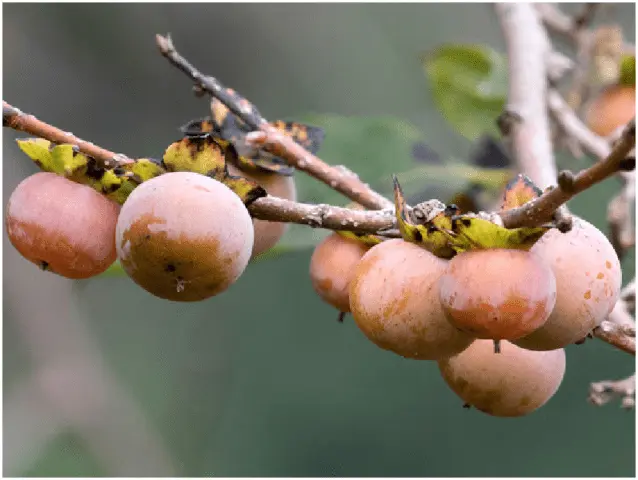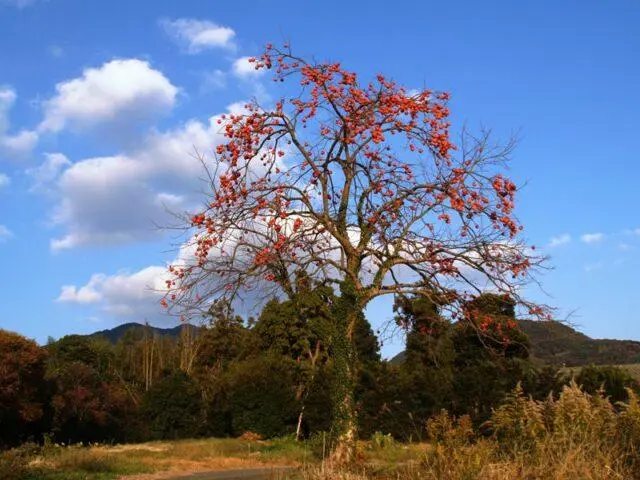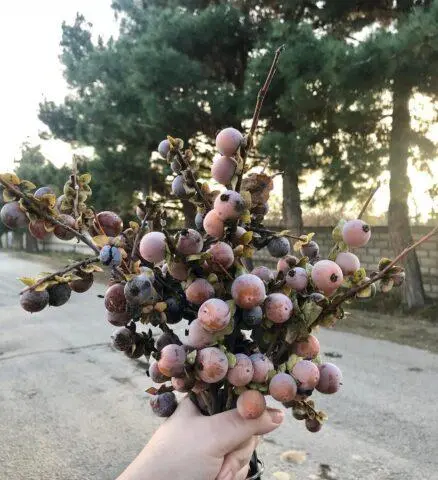Contents
- Description and characteristics of the Caucasian persimmon
- Where and how does the Caucasian persimmon grow
- Does Caucasian persimmon knit
- Composition and calorie content
- The benefits and harms of wild Caucasian persimmon
- Contraindications to use
- Features of growing wild Caucasian persimmon
- Caring for the Caucasian persimmon
- Conclusion
Caucasian persimmon is a type of culture that is found in the North Caucasus, in the Crimea and other neighboring regions. The tree is unpretentious, tolerates frost well. Its fruits are small, but quite suitable for fresh consumption (preferably after cold processing) and for various preparations.
Description and characteristics of the Caucasian persimmon
Wild Caucasian (Diospyros lotus) is a variety of common persimmon. It is a tree up to 30 m high with glossy leathery leaves. The shape of the leaf plate is oval, with a sharp point, reaches a length of 5 to 15 cm, a width of 3 to 6 cm. The bark is light brown, crumbles during aging.
The flowers are small, greenish in color, appear from June to July. The plant is honey-bearing and attracts bees and other pollinators. The fruits of the wild Caucasian persimmon are small, reaching 2 cm in diameter. The pulp is juicy and soft, yellow on the cut. The seeds have a thin skin.

The fruits of the Caucasian persimmon are small, orange
Where and how does the Caucasian persimmon grow
In nature, wild trees grow in the Caucasus, in the Crimea, in the Krasnodar Territory, as well as throughout the Mediterranean (up to Spain). It is found in the subtropical regions of Eurasia, including in certain provinces of China and in northern India. Prefers foothills 300-600 m above sea level, and in Asia – up to 2000 m.
In most cases, the Caucasian persimmon does not grow in separate groups, but in combination with different trees. Its neighbors are often ash trees, maples and other deciduous plants. The tree is not demanding in terms of conditions; therefore, it is often found even on rocky slopes. At the same time, persimmon is demanding on lighting – it grows well only in open places.
Does Caucasian persimmon knit
The composition of the Caucasian wild persimmon, like the cultivated varieties, contains tannins (tannins). Therefore, they are noticeably knit, especially in an unripe state. However, after freezing or drying, these components are destroyed, due to which the taste improves. Sweet tones and slight sourness are noticeable.
The fruits are edible. They are used both fresh and frozen or dried. Soft drinks and tinctures are prepared from them, used for baking. The leaves of the wild Caucasian persimmon go into tea, and an analogue of coffee is prepared from the seeds.
Composition and calorie content
The calorie content of fresh fruits of the Caucasian persimmon is 53 kcal per 100 g. In dried form, the figure is much higher and reaches 250–300 kcal for the same mass. Nutritional value per 100 g (also for dried product):
- proteins – 3,1 g;
- fats – 0,8 g;
- carbohydrates – 57,9
The chemical composition of the Caucasian persimmon contains the same substances as in the pulp of cultivated varieties:
- vitamin C (up to 60% of the daily requirement in 100 g) and A;
- tannins (tannins);
- minerals (phosphorus, iodine, magnesium, iron, calcium, sodium, potassium);
- simple sugars;
- Apple acid.
The bark of the branches contains various triterpenoids and tannins. The leaves are rich in vitamin C and other useful components:
- quinone;
- quercetin;
- Lecocyanidin;
- myricetin and others.

The fruits of the Caucasian persimmon contain vitamin C and other valuable substances.
The benefits and harms of wild Caucasian persimmon
The culture has long been used in folk medicine of the peoples of the Caucasus, in China, Thailand and Japan. Its medicinal properties are diverse:
- anti-inflammatory, bactericidal, wound-healing effect;
- normalization of fat metabolism;
- improved liver function;
- diuretic effect;
- strengthening immunity;
- improvement of the nervous system;
- recovery after long illnesses, operations;
- enuresis treatment.
For medicinal purposes, fruits, leaves and even ponytails are used (a decoction is prepared from them). Applied inside, less often – for external treatment of wounds, pustules and abscesses. To do this, steamed leaves or compresses from their decoction are applied to the affected area.
In some cases, the use of Caucasian persimmon is fraught with harmful consequences:
- burning sensation;
- stomach ache;
- constipation or, conversely, diarrhea;
- nausea and vomiting (use in large quantities).
Contraindications to use
In some cases, the use of Caucasian persimmon should be completely excluded or limited. It is not recommended to include fruits in the diet for the following pathological conditions:
- erosive gastritis;
- ulcer;
- operations on the stomach or intestines;
- adhesive disease;
- chronic constipation (especially in old age);
- diabetes (type one);
- pregnancy and lactation (with limitation);
- children under the age of three;
- individual intolerance to certain substances.
Features of growing wild Caucasian persimmon
This tree is characterized by increased winter hardiness, so it can be grown in the climatic conditions of the Krasnodar Territory, the North Caucasus and the Crimea. Persimmon grows well even on depleted lands, so it is enough for her to provide the minimum conditions:
- watering;
- rare top dressing;
- well-lit area;
- not too wet soil (not in a lowland).

Wild persimmon can be grown on your site
The yield of mature trees reaches 100 kg. Despite the small size of the fruits, they can be collected quite a lot and used for home preparations or sent for processing.
Planting seedlings of Caucasian persimmon
Wild Caucasian persimmon can be propagated by cuttings or grown from seeds. In the first case, at the beginning of summer, they take several green branches 20 cm long (with three internodes) and act like this:
- Make an oblique lower and straight upper cut.
- Put overnight in a solution of “Heteroauxin” or another growth stimulant.
- Planted in fertile, moist soil with plenty of sand (deepen by 3 cm).
- Cover with foil or bottles.
- Water periodically.
- Two weeks after planting, liquid manure or other organic matter is applied. At the same time, the film is removed.
- For the winter they mulch with spruce branches, sawdust, straw and other materials.
- The following spring, seedlings of the Caucasian persimmon are transferred to a permanent place. The site should be lit, protected from the winds, with light fertile soil (although the tree grows normally on depleted soil).
At the bottom of the landing pit, it is necessary to fill in a layer of expanded clay, broken bricks and other small stones 10-15 cm high.
Growing Caucasian persimmon from the stone
You can grow a Caucasian persimmon from a seed. It is planted in autumn, after fruit ripening. It is necessary to act in this way:
- Remove the bone from the fruit and thoroughly rinse it from the remnants of the pulp.
- Put for several hours in a solution of “Heteroauxin” or other growth stimulator.
- Plant in a pot with fertile, loose soil.
- Cover with cling film and place in a warm, shady place.
- Spray periodically.
- Two weeks after the sprouts appear, dig out the bone and carefully remove the shell.
- Transplant outdoors in the spring when there are no frosts.
Caring for the Caucasian persimmon
This plant is undemanding to care, so the cultivation technique is quite simple. Young seedlings are watered weekly, and in drought – twice a week. Mature trees moisturize only in the heat, giving 2-3 buckets. After watering, the trunk circle is dug up, if necessary, weeding is carried out.

Even with minimal care, an adult tree produces up to 100 kg of fruit.
If the soil is fertile, fertilizer can be omitted in the first four years after planting. Then they are given three times a season – in the spring urea or ammonium nitrate (15–20 g per tree), during flowering and at the fruiting stage – superphosphate (40 g) and potassium sulfate (30 g).
Another mandatory event is pruning. It is carried out in early spring and late autumn. Remove dried, diseased, old, barren branches, and also form a crown. The plant is resistant to insects and other pests, so it is not necessary to treat with drugs.
Conclusion
Caucasian persimmon is quite productive, so it can be grown for home use and industrial processing. The plant bears tasty fruits that are not inferior to cultivated varieties. They are used both for cooking and for medicinal purposes (along with the leaves).









